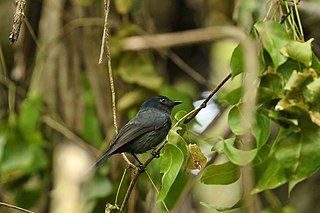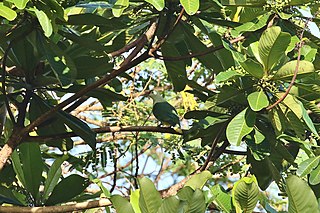
Pseudovanilla, commonly known as giant climbing orchids, is a genus of eight climbing orchids in the family Orchidaceae. Orchids in this genus have tall climbing stems with clinging roots, leaf-like bracts and branching flowering stems with colourful, spreading sepals and petals. Species in the genus are native to Indonesia, the Philippines, New Guinea, Australia, Solomons, Micronesia and Fiji.

Cytaea is a genus of spiders in the family Salticidae.
Efate is a genus of the spider family Salticidae.
Sobasina is a genus of jumping spiders that was first described by Eugène Louis Simon in 1898. These spiders look somewhat like ants, except for S. paradoxa, which looks more like a beetle.

Trite is a genus of jumping spiders first described by Eugène Simon in 1885. Most of the 18 described species occur in Australia and New Zealand, with several spread over islands of Oceania, one species even reaching Rapa in French Polynesia.
Xenocytaea is a genus of spiders in the family Salticidae (jumping spiders).

Zenodorus is a genus of the jumping spiders distributed from the Moluccas to Australia, including several islands of the Pacific. It was once considered a junior synonym of Omoedus, but this was later rejected by Jerzy Prószyński in 2017. At least one species, Z. orbiculatus, specializes on hunting ants.
Xenocytaea anomala is a jumping spider.
Cytaea carolinensis is a species of jumping spiders.
Cytaea koronivia is a species of jumping spiders.
Cytaea nausori is a species of jumping spiders.
Cytaea rai is a species of jumping spider.
Cytaea vitiensis is a species of jumping spider.
Sobasina yapensis is a species of jumping spider.
Sobasina coriacea is a species of jumping spider.

Corybas, commonly known as helmet orchids, is a genus of about 120 species of plants in the orchid family, Orchidaceae. Helmet orchids are small, perennial, deciduous herbs and are nearly always terrestrial. They have a single leaf at their base and a single flower on a short stalk, the flower dominated by its large dorsal sepal and labellum. Species of Corybas are found in Australia, New Zealand, New Guinea, Southeast Asia, the Himalayas, southern China, many Pacific islands and a few sub-Antarctic islands.

The Pohnpei flycatcher is a species of bird in the family Monarchidae. It is endemic to Micronesia and can be found on the Caroline Islands.

The purple-capped fruit dove or Pohnpei fruit dove, is a species of bird in the family Columbidae found on Chuuk and Pohnpei in the Caroline Islands. It was formerly considered as a subspecies of the crimson-crowned fruit dove. Its natural habitats are subtropical or tropical moist lowland forests and subtropical or tropical mangrove forests.

Cyrtophora moluccensis is a tent-web spider in the orb-weaver family. It is commonly known as the tent spider or dome-web spider, and is native to India, Japan, Indonesia, Papua New Guinea, Australia, Fiji, and Tonga. It is often found in disturbed or open habitats from coasts to forest and mountainous interiors.
Cytaea taveuniensis is a jumping spider species in the genus Cytaea. The male was first identified in 2010 by Barbara Maria Patoleta and Joanna Gardzińska. The female has not been described.







